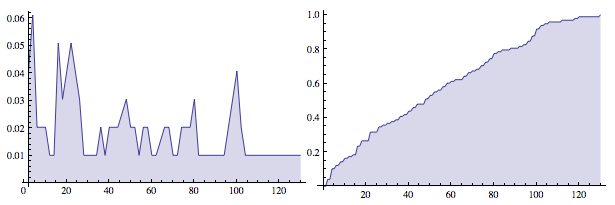Note: this is fixed in version 9.
My question concerns the usage of NExpectation and Expectation and why I see the behavior I see in the following example.
First take some data and derive an EmpiricalDistribution:
data = {4, 104, 96, 80, 22, 76, 106, 18, 98, 44, 112, 78, 50, 120, 2, 6,
100, 10, 68, 80, 42, 66, 100, 58, 4, 76, 18, 102, 6, 16, 52, 32, 62,
36, 18, 4, 54, 98, 38, 74, 16, 22, 102, 2, 2, 4, 22, 72, 100, 82, 48,
16, 34, 44, 130, 50, 48, 74, 60, 96, 8, 118, 30, 58, 84, 4, 70, 66,
40, 14, 92, 68, 42, 56, 56, 16, 40, 12, 22, 26, 98, 4, 80, 100, 36,
88, 48, 26, 28, 94, 22, 26, 78, 16, 52, 8, 10, 2};
dist = EmpiricalDistribution[data];
You can plot PDFs and CDFs of the distribution:
Row[{DiscretePlot[PDF[dist, x], {x, data}, Joined -> True, ImageSize -> 300],
DiscretePlot[CDF[dist, x], {x, 0, Max@data, 1}, Joined -> True, ImageSize -> 300]}]
They look like this:

That covers the background. Now execute the following and it gets a little odd:
Expectation[X \[Conditioned] X > 4, X \[Distributed] dist]
NExpectation[X \[Conditioned] X > 4, X \[Distributed] dist]
N[Expectation[X \[Conditioned] X > 4, X \[Distributed] dist]]
620/11
NExpectation[X \[Conditioned] X > 4, X \[Distributed]DataDistribution[<<"Empirical">>, {51}]]
56.3636
So, what gives?
How come NExpectation[...] doesn't calculate an answer, but N[Expectation[...]] does? Clearly, Expectation handles EmpiricalDistribution without a problem. One would think that NExpectation would as well. Doesn't this seem odd? Just hoping that understanding why Mathematica does this might yield additional insights into Mathematica itself.

HistogramDistributionworks as expected in all 3 cases. $\endgroup$TracePrintofNExpectation. For a kernel function it's extremely verbose. $\endgroup$